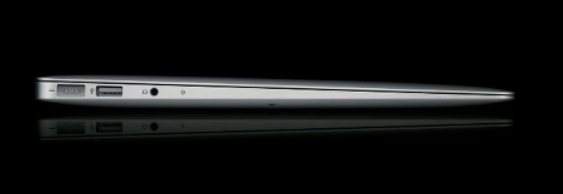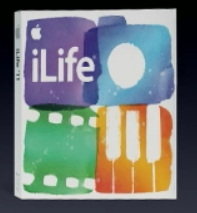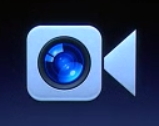|
|
The PrologueBy 7:30 pm last night (Wednesday), the rumours were coming thick and fast with more than 4 hours to go before the start of Apple's event at the Cupertino Town Hall. We had heard for weeks before that there was a new MacBook Air in the wings, perhaps with a smaller 11" screen, and as the time neared we also heard that iLife was to be updated, which is no surprise as it is one of Apple's core bundled suites and is overdue for a 64-bit version. Would iWork also have the 64-bit treatment: and what of a mystery component to iLife to replace iDVD? Several sites had carried pictures and specifications for what was purported to be the new MacBook Air which had four batteries shown and no hard disk, prompting much speculation. It looked rather un-Apple-like to me with the battery placement: it lacked the Ives' balance [see below].
ACT ISteve Jobs: enter stage rightHe sets the scene with a basic outline and immediately invites Tim Cook up to explain about the state of the Art with Macs. Enter Cook Exit Jobs
The rise in numbers of Macs used has lead to a rise in developers to the platform which now stands at 600,000 with some 30,000 added each month. Cook expressed his pleasure that Autodesk had returned with its AutoCAD and also highlighted Microsoft's efforts with Office and praised Outlook. The customer experience includes the Apple 318 retail shops that keep adding customers and adding to revenue, especially the newest ones in China. The momentum, he said, had never been more. Exit Cook
ACT II: iLIFEEnter Jobs He asked audience members to silence their phones. Quite right too: he should try a meeting in Thailand. Then the new products. After a brief outline he announced iLife 11 with the same apps (which was a slight surprise.
iPhotoFull screen mode and Facebook had been well received, so these have been improved. Mail was beefed up and slideshows improved. The feature of creating books, which is only fully available in some markets, has been improved, and Apple is adding Letterpress cards to the tricks in the application.Enter Phil Schiller stage left Exit Jobs
Instead of leaving iPhoto and entering Mail, sending photographs now creates a Mail message inside iPhone and includes the photos and a theme. Photos may be shared with other services such as Facebook and Flickr. Comments posted on Facebook will now appear in iPhoto next to the image. Creating a book has a nice change in that after selecting a group of photos the ones chosen are displayed in a carousel of book themes, so we may see what the production would look like before selecting the specific theme. The book has several new ways to display images and can even group photos by time, as well as allowing customization, including the background of a specific page. Project view, looking just like the iBooks display, shows all the project s a user has created and this is another way to view the photographs. Also in this view we were shown cards. Selection uses a carousel like the book selection. To end, Schiller showed a brief video that is also included in iPhoto that explains how letterpress cards are made. Exit Schiller Enter Jobs
iMovieThis is why we do what we do, he said, then reprised what had just been presented then looked at iMovie. User experience, he said, demanded better audio editing and this was taken up. To make it easier the new iMovie had a number of features he summarized: one step effects, for making movies more easily; a people finder to track down clips of people that uses the face detection technology from iPhoto; news and sports themes; and the ability to make movie trailers easily.Enter Randy Ubillos (Chief Architect Video Applications) Exit Jobs
Like the effects, making movie trailers uses 15 built-in themes and by entering a few details, making a few clicks, the application will assemble a movie trailer, credits and all. As a note, the music was recorded at Abbey Road by the London Symphony Orchestra: part of a consumer application that comes free with all new Macs. This trailer feature works superbly and was well-received. Ubillos was justifiably confident when he showed two more of these trailers. Exit Ubillos Enter Jobs
GarageBandJobs outlined the application and highlighted some of the new effects, like Flextime, Groove Matching, many more effects, as well as new lessons (again these will probably not be available in the Thai market due to copyright restrictions).Enter Xander Soren Exit Jobs
Learn to Play has been expanded somewhat and a new feature is How did I Play which compares the music with the user's actual output, marking wrong notes in red and timing errors in yellow. A percentage score is also displayed. The software keeps a history so that the learner is able to keep track of how learning progresses. Exit Enter Jobs
ACT III: FACETIME
With 19 million such devices shipped, a major request from consumer was for Facetime between the devices and the Mac. And here it is working with a similar interface on the Mac to what I have in my iPhone 4. it works when we use wifi, and users may dial out to a suitable phone or use the phone to connect to a Facetime equipped computer; or from computer to computer. A beta of the feature shipped and I downloaded it right away. In good wifi areas it works as expected, although I had problems at work, but then I always have problems at work with the flaky setups there and that is no test for any technology. What I want to know is who pays for the call from a computer to a phone?
ACT IV: OS X LIONThe philosophy behind this upgrade is by starting with OS X, and creating iOS, the technology for the iPhone and iPod touch, and later as the OS for the iPad there seems to be a closing of the circle: indeed, the slide showed this as a series of linked arrows. The innovations are now coming back to the Mac: the theme of the day's events. Mac OS X meets the iPad. Some of the key features of Lion include Multi-touch gestures; an App Store for Macs; App Home Screens; Full home screens; Auto save; Apps resume when launched. Steve explained the bad ergonomics of touch gestures on a vertical screen and led into the perfecting of the multi-touch trackpads, including the Magic Mouse and Magic Trackpad, although the patent for a horizontal screen iMac did come to mind as he spoke. He commented on the success of the App Store for the iPhone and iPad: 7 Billion downloads. This success is to be built on with a Mac App Store as part of Lion. It will be similar to the iPhone App Store including the 70/30 split for developers. Also like the iPhone apps, they will automatically install and be updated. This sounds as if it wil remove much heartache, particularly for new users, if it works as mooted. A slight difference from the usual approach is that the apps will be licensed for all a user's Macs: I find that most attractive. Features in OS X now that have been around for a while and add to productivity for users, include Exposé, Dashboard, Spaces, and Full Screen Apps. Apple intends to unify these four in something they call Mission Control. I worry about some of the names Apple gives to technologies or features. Enter Craig Federighi Exit Jobs
Launchpad may work something like Dashboard in the way that those App Store downloads are organised, stored and activated. Like iOS, folders are available so organisation is easy. Federighi also demonstrated the way that some of the apps work in full screen mode and how to flick between the screens. With multiple applications open, by using the new Mission Control, anything open on the Mac is viewed in a single display, slightly reminiscent of a 4-finger gesture on a trackpad. Exit Craig Federighi Enter Jobs
These are the things we wanted to share with you today. We are really excited about it.
ACT V: ONE MORE THING"But there is one more thing. . . ." The One More Thing is a re-emphasis of Back to the Mac, the theme of this event; and the idea of the circle nature of development. The iPad inspiring the Mac: instant on, battery life, good standby time, solid state storage, thin and light. What would happen if an iPad and a Mac hooked up? Laughter from the audience. The new MacBook Air. At its thickest point it is 0.68" and goes down to 0.11" Using the Unibody construction means the body is rigid and the computer has a full size keyboard.
A slide of the insides showed the four batteries although these were in a matte black finish and much tidier than the earlier shots that had circulated on the Internet: much more like Apple and Ives. And there is more: a younger brother with an 11.6" screen. It has all the features of the larger unit (but 1366 x 768 pixels), with battery life of 5 hours and the same 30 days standby time. Prices are $999 for the 11.6" version with 64G of flash; $1199 for the 11.6" with 128G; $1299 for the 13.3" with 128G; and $1599 for the 13.3" with 256G. Prices in Thailand are 34,900 baht 40,900 baht 44,900 baht and 55,900 baht respectively and they are on sale now in the Thai online store. The 11.6" machines have 1.4Ghz processors, while the 13'3" ones have 1.86GHz processors, which some thought was a little underpowered.

The end of the event approached with an advertisement as well as a video with Jony Ive, Phil Schiller and Bob Mansfield, which showed part of the process of making the device using water and laser cutters as well as some neat explanations by the presenters. A closing comment was made after the videos and the stage was bare. Exeunt
|
|

 Using a Magic mouse he showed full screen mode of iPhoto initially and showed how Events organises photographs with a claimed performance boost. He showed Faces and Places too. These are all current but the new version has some little tricks added to make the user experience better and instead of searching through loads of menus, the user is in direct touch with what is wanted, such as a slideshow which works far better with the included technologies. Album View is also a new way to view images and from here too it is easy to come up with a slideshow. Schiller demonstrated a couple of the new themes which are clearly aimed at consumers and not professionals.
Using a Magic mouse he showed full screen mode of iPhoto initially and showed how Events organises photographs with a claimed performance boost. He showed Faces and Places too. These are all current but the new version has some little tricks added to make the user experience better and instead of searching through loads of menus, the user is in direct touch with what is wanted, such as a slideshow which works far better with the included technologies. Album View is also a new way to view images and from here too it is easy to come up with a slideshow. Schiller demonstrated a couple of the new themes which are clearly aimed at consumers and not professionals. This is a feature of the iPhone 4 and the latest iPod touch.
This is a feature of the iPhone 4 and the latest iPod touch. 

